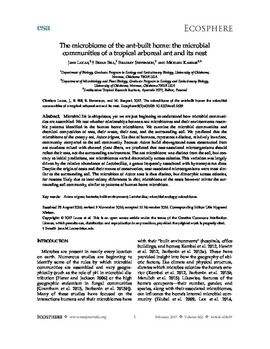| dc.creator | Lucas, Jane | |
| dc.creator | Bill, Brian | |
| dc.creator | Stevenson, Bradley | |
| dc.creator | Kaspari, Michael | |
| dc.date.accessioned | 2017-03-02T19:00:29Z | |
| dc.date.available | 2017-03-02T19:00:29Z | |
| dc.date.issued | 2017-02-22 | |
| dc.identifier.citation | Lucas, J., B. Bill, B. Stevenson, and M. Kaspari. 2017. The microbiome of the ant-built home: the microbial communities of a tropical arboreal ant and its nest. Ecosphere 8(2):e01639. 10.1002/ecs2.1639 | en_US |
| dc.identifier.uri | https://hdl.handle.net/11244/49227 | |
| dc.description.abstract | Microbial life is ubiquitous, yet we are just beginning to understand how microbial communities are assembled. We test whether relationships between ant microbiomes and their environments resemble patterns identified in the human home microbiome. We examine the microbial communities and chemical composition of ants, their waste, their nest, and the surrounding soil. We predicted that the microbiome of the canopy ant, Azteca trigona, like that of humans, represents a distinct, relatively invariant, community compared to the soil community. Because Azteca build aboveground nests constructed from ant exudates mixed with chewed plant fibers, we predicted that nest-associated microorganisms should reflect their ants, not the surrounding environment. The ant microbiome was distinct from the soil, but contrary to initial predictions, ant microbiomes varied dramatically across colonies. This variation was largely driven by the relative abundance of Lactobacillus, a genus frequently associated with hymenopteran diets. Despite the origin of nests and their means of construction, nest-associated microorganisms were most similar to the surrounding soil. The microbiota of Azteca ants is thus distinct, but dimorphic across colonies, for reasons likely due to inter-colony differences in diet; microbiotas of the nests however mirror the surrounding soil community, similar to patterns of human home microbiota. | en_US |
| dc.description.sponsorship | This work was supported by the National Science Foundation (EF—1065844) to Michael Kaspari, the National Science Foundation Graduate Research Fellowship (2014170874) to Jane Lucas, Smithsonian Tropical Research Institute Short-Term Fellowship to Jane Lucas, and University of Oklahoma Biology Department Funds. | en_US |
| dc.format.extent | 14 pages | |
| dc.format.extent | 1,731,196 bytes | |
| dc.format.medium | application.pdf | |
| dc.language | en_US | en_US |
| dc.relation.requires | Adobe Acrobat Reader | |
| dc.rights | Attribution 3.0 United States | * |
| dc.rights.uri | https://creativecommons.org/licenses/by/3.0/us/ | * |
| dc.subject.lcsh | Ant communities | |
| dc.subject.lcsh | Azteca (Insects) -- Ecology | |
| dc.subject.lcsh | Azteca (Insects) -- Nests | |
| dc.subject.lcsh | Bacterial communities | |
| dc.subject.lcsh | Lactobacillus -- Ecology | |
| dc.title | The microbiome of the ant-built home : the microbial communities of a tropical arboreal ant and its nest | en_US |
| dc.type | Article | en_US |
| dc.type | text | |
| dc.description.peerreview | Yes | en_US |
| dc.identifier.doi | 10.1002/ecs2.1639 | en_US |
| ou.group | College of Arts and Sciences::Department of Biology | en_US |
| dc.subject.keywords | Azteca trigona | |

